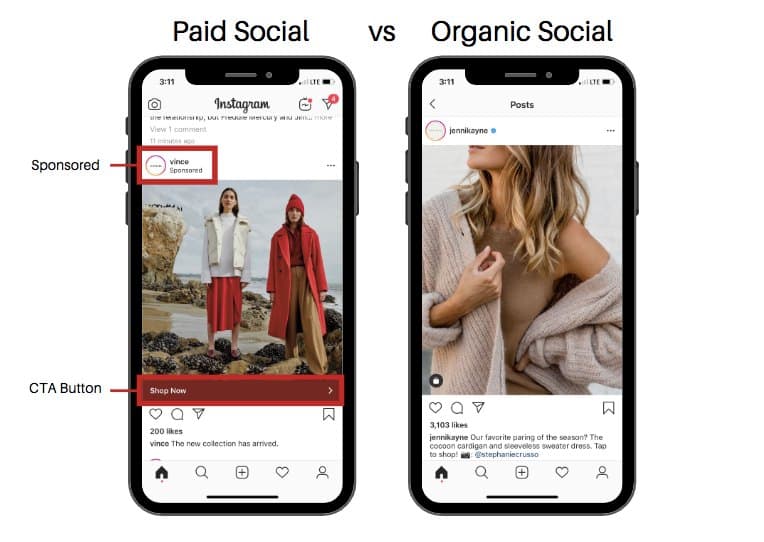Using social media to promote your small business allows you to connect and engage with your audience organically. It lets people know your business is accessible and present, which can make all the difference in getting your brand found and chosen over a competitor. To get started, choose the best platforms for your audience, learn the basics, and set goals, strategies, and your budget. Then lay it all out on a calendar and track your performance.
Download Our Social Media Marketing Plan Template
Download our social media marketing plan template below. Use it to give direction to your campaigns and save time and money by ensuring that all your social media marketing efforts match your goals.
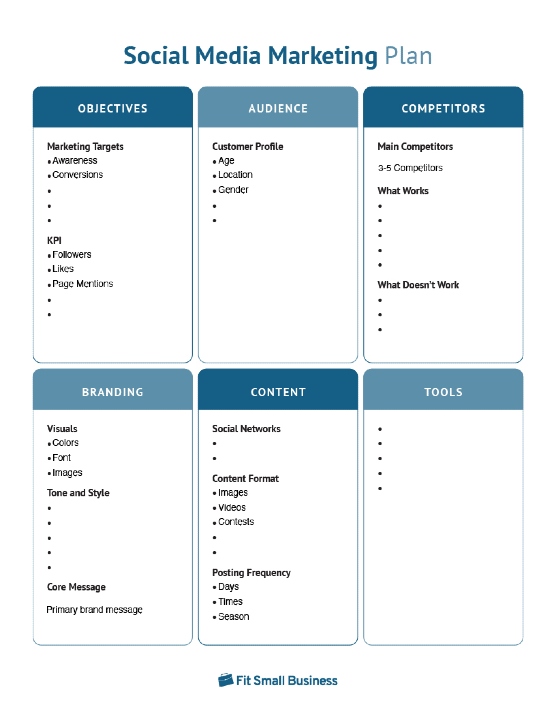
Thank you for downloading!
💡 Quick Tip:
Save time and manage all of your social posting in one place. Plan, analyze, and schedule content in advance affordably with Later!
1. Decide Which Platforms Are Best for Your Business
Social media marketing is a must for any business whose target audience spends significant time on social networks. There are many social media platforms small businesses can use to reach and connect with various target audiences, so knowing which to invest your time and resources on is important.
Before getting started, decide which are the top one or two platforms your target audience uses most (as well as where they’re most likely to engage with brands). On your chosen platform, create a business profile by adding your name and profile picture and/or cover image and optimizing your profile by completing all the sections available.
Social Media Marketing for Small Business: Top Platforms at a Glance
# of Users* | Demographics | Ideal For | Average CPC** (Paid Ads) | |
|---|---|---|---|---|
Facebook | 3.03 billion | Ages 25–34 Gen X |
| 51 cents |
Instagram | 2.35 billion | Ages 18–34 Millennials |
| $1.28 |
TikTok | 1.67 billion | Ages 10–24 Female (54%) |
| 2 cents |
Snapchat | 750 million | Ages 18-24 Generation Z |
| 82 cents |
Pinterest | 450 million | Ages 30–64 Female (77%) |
| 80 cents |
X (Previously Twitter) | 368.4 million | Ages 18-29 Male (61.29%) |
| $5.26 |
LinkedIn | 310 million | Ages 30-39 Professionals |
| $7.50 |
*As of August 2023 **Cost per click | ||||
Learn more about each of the most popular options for small business social media marketing in the drop-downs below:
Primary user intent: Users of all ages, including a large number of users 50-plus years old, looking to keep up with friends and family
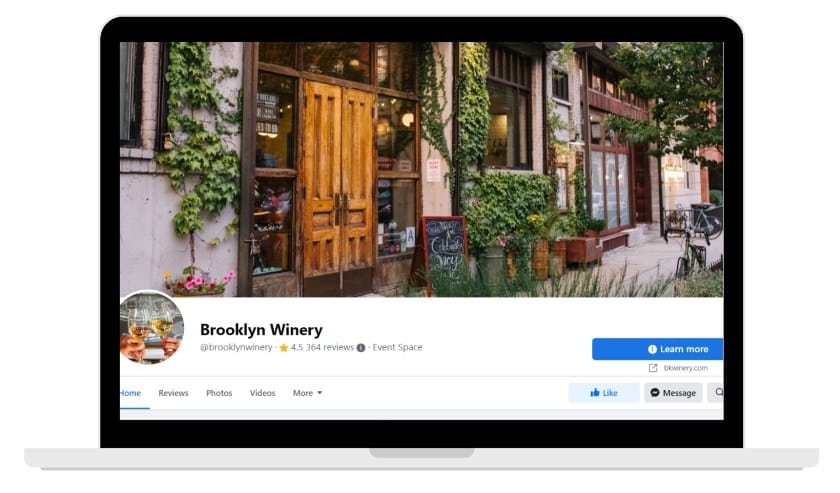
Facebook business page for small business example (Source: Facebook)
Facebook is the leading social networking platform, reaching users of all ages, backgrounds, and interests. Small business social media marketing can be done in various ways on Facebook. For example, you can create a business page that links to your website and provides useful info like hours and reviews, start and participate in private groups, and run targeted ads.
In most cases, users are not there to learn about businesses per se, but will often ask their Facebook connections for recommendations and user experiences. Also, ads can be highly targeted, offering businesses an effective way to establish brand awareness and generate sales using paid ads.
Learn the different marketing strategies for Facebook pages to help market your business page and follow these simple tips for social media marketing business pages on Facebook:
- Post once each day
- Upload high-quality multimedia content
- Create or join Facebook Groups and engage with members
- Boost important or high-performing posts via Facebook Ads
- Start a Facebook contest to add followers and increase activity
- List your products on Facebook Marketplace
Primary user intent: To keep up with trends and brands through visual media
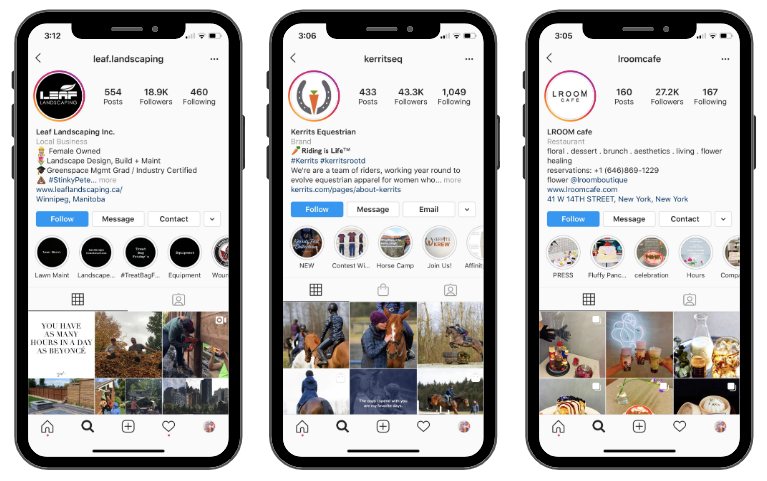
Instagram business profiles examples (Source: Instagram)
Instagram is the top social network for photo and video sharing. It reaches a wide audience, and like Facebook, businesses can create business profiles and advertise on the platform. It’s also the social media platform with the highest purchase intent, meaning its users are most ready to buy.
Since Instagram is multimedia-based, it is best for businesses with images and short videos to share. It also allows users to tag businesses geographically, so it’s great for businesses with a physical location, such as a restaurant, retail store, or salon.
Follow these steps on how to sell on Instagram to boost your sales and keep these best practices in mind:
- Develop a brand aesthetic
- Use community- or industry-specific hashtags
- Show products on your stories
- Work with IG influencers
- Run contests or giveaways
Primary user intent: Users seeking to watch entertaining or emotional content on specific interests
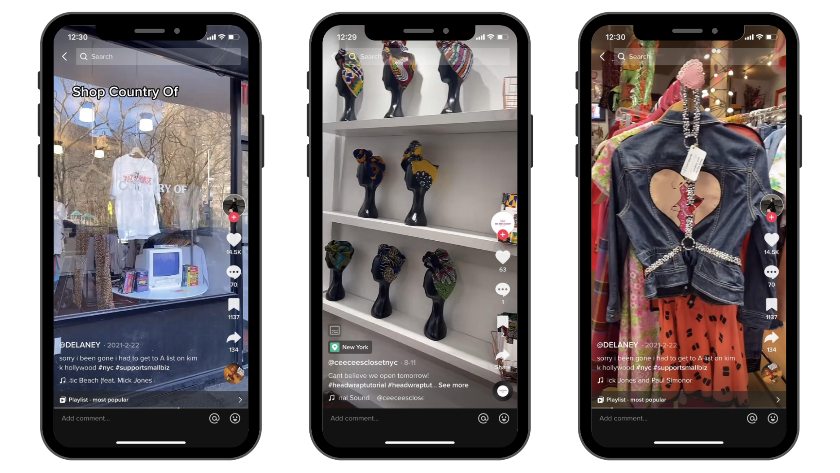
Business videos on TikTok examples (Source: TikTok)
TikTok is a video-sharing app businesses can use for social media promotion with short-form videos that quickly became popular over the past few years.
Originally, TikTok didn’t compete with other platforms as a small business social media marketing channel. But with its user base skyrocketing, businesses are able to effectively leverage hashtags, contests, and other brand-related content to promote their products.
To improve your TikTok social media marketing campaigns, here are some of the best practices to remember:
- Use hashtags
- Utilize trending video effects and music
- Post often
- Research viral audio and trends
- Write clear text descriptions for your videos
Interested in learning more? Read how to create a TikTok marketing strategy for your small business.
Primary user intent: To share intimate yet trivial visual content directly with friends; primarily a Millennial and younger user base

Snapchat business messages and shareable content (Source: Snapchat)
Like Instagram, Snapchat is a photo- and video-sharing social network. However, it differs with its ephemeral content model—photos, texts, and videos sent directly to users disappear after they have been seen.
Businesses can use the platform by adding branded filters customers and brand advocates can use on their photos as well as sharing content. Plus, Snapchat can be used in social media marketing for a small business by featuring short video ads in their Snapchat stories. Authentic storytelling does best on this platform, so even Snapchat ads should offer personal, raw content.
Here are some of the practices proven to be effective in Snapchat marketing:
- Use both photos and videos
- Encourage viewers to screenshot and share your Snaps
- Create and promote Geofilters
- Post Q&As
- Hold giveaways
Primary user intent: To get inspiration on a wide range of topics, from fashion to cooking
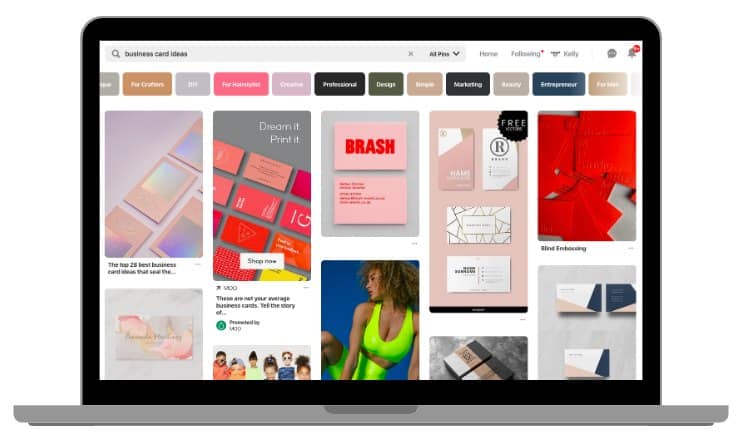
Pinterest search results for product-related inquiries (Source: Pinterest)
Pinterest is a photo-sharing social network used for content discovery. Unlike Instagram, where users primarily view photos from those they follow, users on Pinterest search by category or search terms and are then shown several relevant image-based results. These results, or posts, are generally linked to websites, so it’s a good way for businesses to build awareness of visual products and services and drive traffic to their site.
Learn how to use Pinterest for business to gain more clicks to your website or online shop, and follow these best practices:
- Include a link to your website in the pin descriptions
- Schedule your pins
- Apply for Rich Pins
- Optimize your image specifically for Pinterest
- Keep pin descriptions below 100 characters
Did you know? Rich Pins are a free Pinterest feature that adds context to your posts. It works by drawing metadata from your website.
Primary user intent: Users seeking quick-hit, entertaining, and newsworthy content
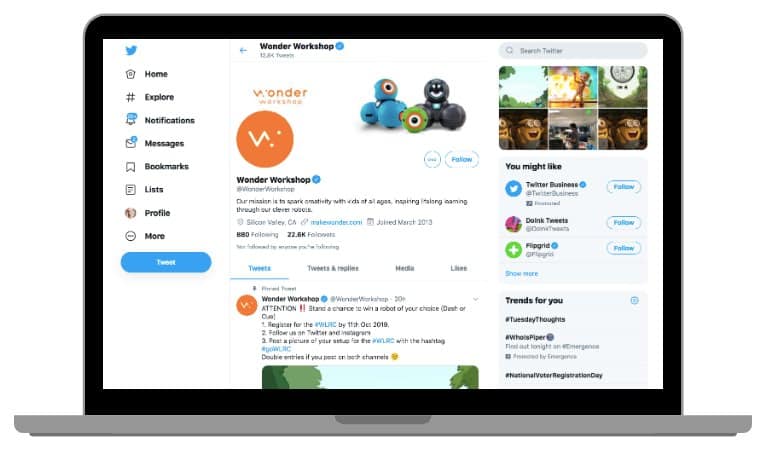
X business profile for newsworthy content (Source: X)
X, the new branding of Twitter, is the leading text-based social network. While it has evolved to allow users to post photos and videos, it was built to share short streams of text (originally just 140 characters, the current character limit is 280) and this is still its primary use. As such, it’s best for frequent, quick-hit news and updates, such as a small business hosting an event or workshop or a food truck that needs a way to quickly share its current location. Learn more about creating an effective X marketing strategy.
Because of its direct form of communication, X is often used by businesses as a customer service channel. It encourages quick and sincere responses to brand followers. Like Instagram, it’s also highly hashtag-oriented, and users often click on hashtags when following a story or researching a topic.
Learn how to use X for customer service here, and follow these general best practices when using X for social media marketing:
- Post frequently
- Post video content
- Incorporate calls to action (CTAs) in posts with links to your website
- Create polls to increase engagement rates
- Use hashtags, but don’t overdo it; just one or two per post
- Track brand mentions
Primary user intent: Professionals looking to network with others in their industry
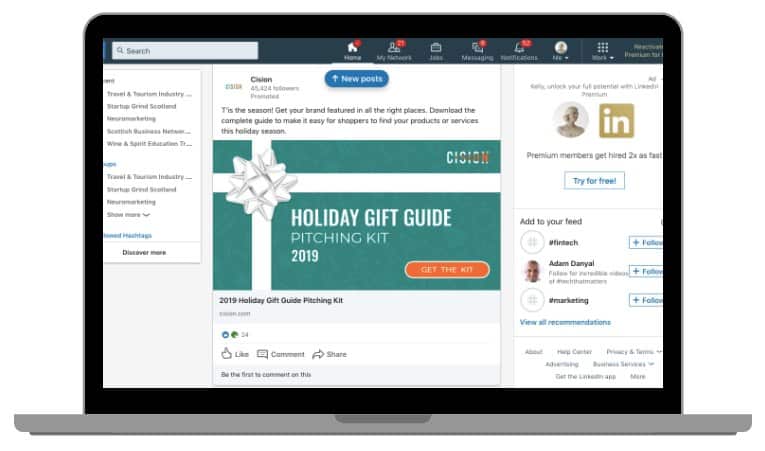
LinkedIn business post example (Source: LinkedIn)
LinkedIn is the leading social network for professional networking. Unlike social networks like Facebook and Instagram, users visit LinkedIn for professional and career-related purposes. Like Pinterest, user posts often link back to website and blog content, making it an effective way to build brand awareness and drive web traffic for lead generation, nurturing, and sales. But to put LinkedIn to use in your marketing, you’ll need to develop a specific LinkedIn marketing plan.
Small businesses have both organic and paid social media marketing opportunities with LinkedIn. Like Facebook Ads, paid ads on LinkedIn can be highly targeted as a cost-effective way to reach your intended audience. Given LinkedIn’s audience and professional networking focus, it’s best for recruiting, software as a service (SaaS), B2B marketing, and educational topics.
Here are some best practices for small business social media marketing on LinkedIn:
- Write original content for LinkedIn that links back to your website content as part of your overall content marketing plan and strategy
- Share your blog content in posts to drive web traffic
- Create and join groups for targeted networking
- Increase engagement using short-form video
- Get a paid plan to access direct message marketing on LinkedIn
Looking for the best social channels for advertising? Read our guide on the top 10 paid social platforms for promoting your small business.
2. Learn the Basics of Social Media Marketing for Small Business
Social marketing refers to a digital marketing strategy for using social media to promote brands and engage with people. It involves posting updates, sharing videos, responding to comments, running ads, and analyzing performance to optimize the campaign. Here are the basic terms you should know before getting started:
- Algorithm: A set of rules used by social media platforms to decide what content to show users on their feeds based on relevance and engagement
- Boosted Post: An organic post that gets more reach when a brand pays to boost it
- Clickbait: Sensational or misleading content designed to attract clicks and engagement, often promising more than it delivers
- Disappearing content: Content that automatically vanishes after a certain time, like Stories on Instagram and Snapchat
- Geotagging and geotargeting: Using location-based information in posts or targeting options
- Handle: The username associated with an individual or brand account on social media
- Impressions: The number of times an ad or post appeared on-page in a user’s feed
- Post: An organic post that appears in the newsfeed of people who follow a brand or another social media user
- Paid social metrics: Social ad performance and costs are often conveyed with terms like CPC (cost-per-click), CPL (cost-per-lead), CPA (cost-per-action), CTR (click-through rate), and CPM (cost-per-mille, which stands for a thousand impressions)
- Reach: The total number of unique users who see a post or content (paid or organic)
- Social listening: A proactive strategy of monitoring and analyzing social platforms for mentions, comments, and discussions related to your brand to gain insights into brand perception, and one of the top ways to use artificial intelligence (AI) in social media
- Targeting: The options offered by social ad platforms for targeting ads to appear in the news feed for specific types of users (e.g., based on interest, job types, location, and more)
- Influencer Marketing: Influencers are social media personalities who have large followings and drive business to products or companies. Get inspired with these influencer marketing campaigns.
- User generated content (UGC): Content created by users and customers of a brand, often in the form of reviews, testimonials, or posts, which can be shared and repurposed by the brand for marketing purposes
By taking the time to master these basic concepts, you’ll equip yourself to maximize the impact of your social media efforts. Social media plays an increasingly vital role in small business, as more and more customers turn to social media to research brands, check references and referrals, and connect with companies they’re considering doing business with. In fact, many small businesses neglect the importance of social media, even though social media marketing statistics suggest they shouldn’t.
3. Set Measurable Goals
Next, set measurable goals. This will ensure that you are getting a sufficient return on the investment of your time and other resources. Based on these goals, in the next step, you’ll determine which strategies would be best to pursue. Below are some of the most common goals for social media marketing:
- Increasing brand awareness: Growing your brand presence is about making members of your target audience aware of your brand and its position in the marketplace. On social media, you’ll measure this through your number of followers, post reach, and engagement, as well as clicks and web traffic generated through paid social.
- Growing community and engagement: Encourage followers and viewers to interact with your brand to build community and brand affinity and generate engagement and referrals. Measure your progress through engagement per post and page mentions.
- Generating leads and sales: Effective strategies enable you to increase sales and gather information on potential clients. Measure this through lead conversion, the number of leads generated from social media, and prospect engagement in the form of ad clicks, direct messages, comments, likes, shares, and so on.
- Improving customer support: Social platforms offer an effective way to nurture client relationships and improve customer satisfaction. Measure your success with response time and customer satisfaction scores.
- Driving website traffic: Paid and organic social should drive site visits to your website. You can measure this through organic and paid profile analytics, tracked links, social media share of overall traffic, and post clicks.
Get more guidance on how to set goals and measure performance in our guide on how to set sales goals, which also includes a free template.
4. Choose Which Strategies to Use
To maximize your marketing efforts and set your brand apart, align your social media marketing strategies directly to your goals. For example, holding contests and giveaways can help increase brand awareness, while posting educational videos can promote lead generation or help customers who are looking for support.
Both organic and paid posts can drive traffic back to your website, and you can post content for free on social media platforms for organic outreach. However, most also have paid social advertising options to help you grow your following more quickly, drive traffic to your site, or produce sales, email subscriptions, and other conversions.
Organic vs Paid Social Media Marketing
There are two primary types of social media marketing for small businesses to consider: organic and paid. Organic tactics are free, whereas paid social is a form of advertising. It is also generally more time-consuming to build an engaged following with organic vs paid social. On the other hand, paid social posts—which cost from $1 to $2 per click on average—increase target audience impressions and engagement quickly.
For best results in the short and long term, use organic and paid tactics in tandem. For example, on Facebook, you can boost a high-performing post to extend its reach among your target audience even further. You can also supplement advertising efforts with organic posts. Consider posting about a product’s features and benefits in organic posts relative to the products you’re advertising through paid social.
Expand the sections below to dive deeper into each strategy:
Other tactics to explore include user generated content, live streaming, contests, influencer marketing, and social listening. If you’re not sure where to start, read Semrush’s article on the fundamentals of social media marketing and adapt it for your business. Or, take your social media marketing to the next level—get certified with HubSpot’s free course on social media marketing.
Pro Tip: While some don’t include YouTube on their list of social media marketing outlets (we don’t), it’s nevertheless a viable avenue for free marketing and advertising. Check out how you can put YouTube marketing to work for your small business.
5. Create a Social Content Calendar
Next, develop a posting strategy that defines how often and what type of content you’ll post, and when. Now you’re ready to begin outreach efforts to build a following and engage with your audience on social networks using organic and paid social media marketing tactics. Your content calendar should answer the following questions:
- When will you post your content?
- What is the best time of day to post your content?
- What days of the week are best for posting content?
- What platform(s) will you use?
- What type of content will you post?
- What copy, photos, or videos will be included?
- What links or tags will be mentioned?
There are three general methods for creating a content calendar: by hand, using a spreadsheet, or through a content software service. Some people prefer organizing their content on paper, while using a spreadsheet is cost-effective and straightforward. Looking for a free premade template? Try one of the 10 social media calendar templates created by Smartsheet.
6. Set Your Budget
While it’s technically free to use most social platforms, there are expenses involved in social media marketing you’ll need to budget for. In fact, the average small business spends anywhere from $200 to over $2,000 per month on social marketing efforts. This covers everything from labor costs and management fees to design costs, paid collaborations with influencers, and social media marketing tools.
Here are six aspects of social media marketing you may need to budget for:
- Social media management: Small businesses often manage their strategy by hiring a social marketing manager or outsourcing to a social media agency. The average starting cost for outsourced social media management ranges from about $300 to $1,500 per month, which is generally less than the cost of a full-time hire. However, costs could increase depending on factors like the type and extent of services rendered (e.g., posts per week, organic plus paid social, and so on).
- Paid social advertising: Social media advertising is available on virtually all of the top social channels. Small businesses advertising on social pay on a per-click or impressions basis, with cost-per-click averaging around $1 to $2.
- In-house content and media creation: Even if you’re managing your strategy in-house, you should expect to pay for a premium subscription for tools like Canva. Canva offers the ability to streamline content creation with free graphics, images, and design tools, and it’s also our top pick for social AI content writing.
- Professional content creation: Producing quality content often requires professional copywriting, photography, videography, and graphic design. The cost of services like these range from a couple of hundred dollars to upward of a thousand dollars depending on the artist and scope of the project.
- Influencer marketing: Collaborating with online influencers with a large social following can help you build brand awareness and grow your own following. Paying an influencer to mention your brand in posts or review products can cost anywhere from $1,000 to more than $10,000 per post, review, or mention.
- Social media marketing tools: There are many tools that make social media scheduling and performance measurement easy to manage, such as SproutSocial and Later.
Social media marketing is generally a low-cost marketing method, but depending on how aggressively you use it, it could consume a large portion of your overall marketing budget—especially if you use paid social. As you plan your strategy, be sure to keep the potential costs in mind and compare them against your return on investment.
7. Grow Your Followers
Many small businesses struggle to gain traction with social media marketing due to lack of followers and low engagement. After all, it doesn’t do any good to publish consistently to social channels if no one will see your posts. So growing your social media followers base should be a top priority when starting out.
To attract and maintain followers on any platform, you need to publish relevant, entertaining, high-quality content that engages your target audience. Without this, you may find that you lose followers as quickly as you gain them, and you aren’t able to generate any user engagement on the platform to extend your brand’s reach.
To start building your following on social media networks, reach out to existing customers, vendors, professional colleagues, and employees and invite them to follow your profile. Invite email subscribers to like and follow your social profiles. Promote your social media accounts through links and social feeds on your website.
Incentivize people to follow your social profiles by offering special discounts and promos to followers. Collaborate with others to gain awareness, and engage with your target audience by liking and commenting on their profiles or joining and actively participating in private groups.
Keep in mind that regardless of the promises of any paid follower tactic, it’s generally never a good idea to pay for followers. Platforms like Instagram will even penalize your social profile (or ban you from the platform) if they detect that you’re paying for followers. Although it takes more time, follow the best practices of each platform for building your follower base.
Social media marketing is time-consuming, as evidenced by the steps above. For this reason, many small businesses outsource social marketing and advertising to top social media marketing and advertising agencies like LYFE Marketing, instead. LYFE offers a free consultation, making it risk-free to see if their services would be the right fit for your business.
8. Monitor & Tweak Social Media Marketing Campaigns
The sad fact is that a lot of small businesses spend a considerable amount of time and money promoting their brands and products on social channels with little to show for it. Others have some success but don’t have measures in place to show what is working and identify ways to improve their efforts.
Consequently, it’s important for you to have a plan in place to measure results and look for opportunities to improve your results. Some of the key social media marketing success metrics to measure include:
- Number of followers
- Profile and post views
- Organic post engagement (clicks, shares, comments)
- Ad metrics (impressions, click-through rate, cost-per-click, and cost-per-engagement)
- Landing page conversions (e.g., traffic, leads, and sign-ups)
- Sales generated through social media (e.g., traffic to your site, Facebook or Instagram shop sales, and so on)
As you begin to collect data on the performance of your social media marketing efforts, use what you learn to improve future campaigns. For example, a topic that tends to get user comments and more reach could be a topic type to repeat frequently.
You can also test using questions to spark comments, create polls and surveys, and experiment with different types of image formats (single image vs carousel or grid style, for example), as well as videos. And with ads, you can tweak many elements, from visual creatives to audience targeting.
Worried about making mistakes on social media? Read our list of social media fails, mistakes, and blunders, and find out what to do to avoid them.
Frequently Asked Questions (FAQs)
How do small businesses use social media marketing?
Social media marketing is great for small businesses as it provides a fairly even playing field. Any business can use it to build brand awareness with its target audience through organic and paid tactics. Social ads are a proven way to generate leads and sales for small businesses as well as local brand visibility.
Is social media marketing free?
It’s free to promote your business on social media through organic tactics, but you may still need to spend money to promote your small business effectively. For example, you may need to hire a social media manager, use paid social ads, or outsource to a professional agency for a better return on investment. Copywriting, media (e.g., graphics, photos, or videos), and the cost of social media ads can also impact how much you’ll spend on social media marketing.
How much does Facebook advertising cost?
The cost of Facebook ads is calculated either on a pay-per-click (PPC) or per thousand impressions (CPM) basis. The average cost-per-click to advertise your business on Facebook is 51 cents. Facebook currently has a minimum daily ad spend of $5 for ads based on clicks, likes, video views, and post engagements and $1 for impression-based ads.
Bottom Line
For small businesses, social media offers an effective, affordable digital marketing strategy for building brand awareness and connecting with a target audience. To effectively market on social media, determine which platforms your audience is on, set up accounts, and engage your audience to build brand awareness and sales.
Based on our research, the best social media marketing agency for combined organic and paid strategies is LYFE Marketing. It offers targeted insight and guidance on maximizing engagement on social media channels with posts and ads.
